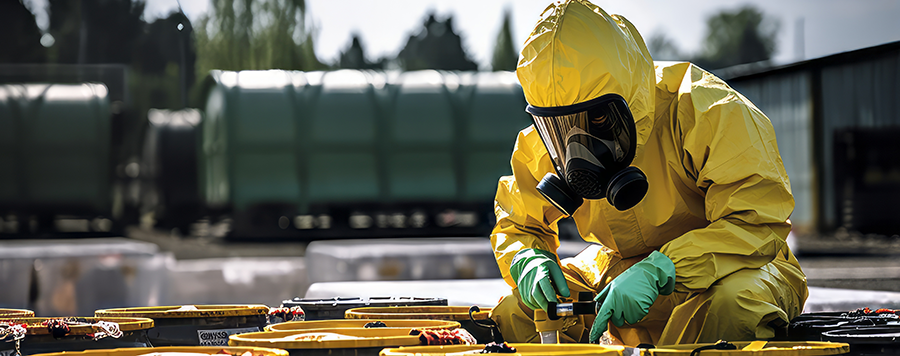Environmental licences, permits and agreements across Australia
Introduction
Environmental laws in Australia are jointly administered by all levels of government (Commonwealth, State and Local Governments). Businesses are required to understand which laws apply to them and to make sure those requirements are met. If an activity is likely to cause harm to the environment, permission may be required in the form of a licence, permit, registration or agreement before that activity can be undertaken.
Why are licences, permits and agreements important?
It is important to understand all the conditions of your licence, permit or agreement to ensure you are able to correctly comply with them and avoid committing an offence. Authorised officers may enter your premises to carry out inspections to regulate a licenced activity, and any failure to hold a required licence, or non-compliance with any licence conditions, may result in prosecution, penalties or another regulatory action.

Environmental authority licences, permits and agreements
If you intend to undertake a polluting activity, you may need a licence from the Environment Protection Authority (EPA) or another environmental authority depending on the jurisdiction. Lists of activities that require a licence can be found in the environment protection legislation administered by the EPA, or other environmental authority, in your jurisdiction. They might include noise, emissions to air or water, or waste management, transport or production.
VICTORIA |
|
| Types of permissions under Victoria’s Permissions Scheme Victoria’s new permissions scheme was introduced in 2021 which includes three levels of permissions under the Environment Protection Act: licences; permits; and registrations. You can use the EPA’s Permissions Proposal Pathway Guideline to help you determine whether you need a permission. |
|
| Licences | Licences are required for prescribed activities. They require the highest level of regulatory control due the high-risk nature of the activity and the substantial risk of harm to the environment or human health or the possibility of mismanagement. Licences contain tailored conditions overseen by the Environment Protection Authority. |
| Permits | Permits are for medium-risk activities such as, but not limited to, some waste and resource recovery activities, waste transport and outdoor events. Permits usually contain a standard set of conditions which may be tailored in certain circumstances, and they are held for a maximum of 5 years (however, they can be renewed prior to expiring). |
| Registrations | Registrations are the lowest regulatory tool applied to low-risk activities and they are usually granted upon application with a standard set of conditions that must be met by the duty holder. Activities requiring registration may include, among others, certain waste treatment activities and organic waste processing, tyre storage, temporary storage of biomedical waste, asbestos or designated waste and dry cleaning. |
SOUTH AUSTRALIA |
|
| Licences | There are two main types of EPA licence in South Australia: licences for activities significant to the environment under the Environment Protection Act 1993 and licences for working with radiation apparatus and substances under the Radiation Protection and Control Act 2021. |
| Exemptions | This kind of authorisation may be granted in certain cases to allow a business to operate beyond the requirements of the Environment Protection Act. |
| Works approvals | In some cases, a works approval may be granted to allow for the construction, alteration or installation of a building, structure, plant or equipment for use for a licenced activity. |

NEW SOUTH WALES |
|
| Environment Protection Licences | Scheduled activities: Activities listed in Part 1 of Schedule 1 of the Protection of the Environment Operations Act (scheduled activities) require a licence by the EPA. These are further broken down into premises-based activities and not-premises based activities. Licences are also required if work is being undertaken to allow a scheduled activity (scheduled development work).
Non-scheduled activities: Licences may be required for activities that are not scheduled activities if they likely to cause water pollution. |
| Risk-based licensing | A risk-based licensing system is used in NSW where the EPA undertakes assessments of licenced premises and determines an overall risk level (levels 1-3). This risk level determines the level of regulatory and compliance oversight required. |
| Load-based licensing | Load-based licensing helps to control air and water pollution by setting pollutant loads which are associated with licence fees as prescribed by the Protection of the Environment Operations (General) Regulation 2009. |
QUEENSLAND |
|
| Environmental Authority | An Environmental Authority is required if you are conducting an environmentally relevant activity (ERA) as detailed in Schedule 2 of the Environment Protection Regulation 2019. Standard applications apply for certain low-risk activities and site-specific applications may be required for higher risk activities. Variation applications apply if you want to vary any of the standard conditions. |
AUSTRALIAN CAPITAL TERRITORY |
|
| Environmental authorisations | Activities that pose a risk to the environment require an environmental authorisation. Those activities are listed in Schedule 1 of the Environment Protection Act 1997. |

NORTHERN TERRITORY |
|
| Environment protection licences and approvals | An environment protection approval or licence is required for the activities listed in Schedule 2 of the Waste Management and Pollution Control Act 1998. |
| Emergency authorisations | An emergency authorisation may be granted if the Minister considers it appropriate in an emergency situation. |
WESTERN AUSTRALIA |
|
| Works approvals | Prior to constructing a prescribed premises, a works approval is required from the Department of Water and Environmental Regulation, and any emissions or discharges from the premises must be authorised by a licence. |
TASMANIA |
|
| Permits and environment protection notices | For activities that are likely to cause environmental harm, a permit or environment protection notice is required. Environmental permit conditions may be issued for permits granted under the Land Use Planning and Approvals Act 1993. Level 2 activities are defined in Schedule 2 of the Environmental Management and Pollution Control Act 1994. |

Other types of licences
You may also need a licence or permit to undertake research or a commercial activity in State parks or waterways, undertake exploration, mining or prospecting activities, discharge trade waste, conduct activities that involve protected species or communities or remove native vegetation. Some of these licences are listed below, however, this is not an exhaustive list, and it is the operator’s responsibility to know whether they need permission to undertake an activity.
Other types of licences |
|
| Agreements under the EPBC Act | Activities that may affect nationally significant plants and animals might require a permit or agreement under the Environment Protection and Biodiversity Conservation Act 1999 (EPBC Act). This could include dumping of waste into Australian waters, accessing marine parks or parks and reserves on commonwealth land for research or other commercial activities, fishing or interacting with listed or protected species, to name a few. |
| Resource licences | A resource licence may be required for mining activities, petroleum activities, geothermal activity and greenhouse storage activities.Further requirements and assessments may be required at the State or Commonwealth level if the activity will have a significant impact on the environment or a matter of national environmental significance. |
| Science and research licences | A scientific licence or permit may be required for scientific research or related activities that involve protected or threatened flora or fauna species, communities or areas. |
| Trade Waste Licence | Trade waste licences are required if you intend to discharge liquid waste emanating from industry, trade, business or manufacturing processes into the sewer system.
Trade waste usually needs to comply with approved acceptance criteria which sets out the physical and chemical characteristics of the trade waste along with discharge rates and levels. |
| Native vegetation clearing | The clearing or removal of native vegetation may require a permit or consent. There are various types of permits, consents and applications that may apply depending on the extent of the proposed clearing. Often, these types of applications are via local council. |
| Biodiversity conservation and wildlife licences | You may be required to hold a licence or permit if you keep or trade wildlife, engage in commercial activities involving wildlife or wildlife control or management. |
| Licence to take water | You may require a licence if you intend to take water from a ground or surface water source such as a lake, dam, river or water bore. |

How can you keep track of your site licences?
Environment Essentials can help you keep track of your licences, permits and agreements all in one place. With our online directory, EnviroLaw, your site-specific requirements can be included as easy-to-read summaries, and you can export those summaries into checklists for easy reference. With our HSE compliance tools, Compliance Register and Compliance AuditTool, you can also integrate the site-specific requirement summaries into your legal registers and audit documents and assess your compliance against your licence, permit and agreement conditions.
Your site-specific requirements will appear under Site Obligations in EnviroLaw. If you don’t have this option but would like to get more information, please contact our Client Services team.
If you don’t have an Environment Essentials subscription, contact us or sign up for a free trial.
![]()
References
- Access Canberra Webpage: Environment Protection Authority
- Australian Business Licence and Information Service Webpage: Licence to Discharge Trade Waste – Victoria
- Australian Government, Business Webpage: Manage Your Environmental Impact
- Business Queensland Webpage: Environmentally Relevant Activities
- Business Queensland Webpage: Types of Applications for a New Environmental Authority
- EPA Victoria Webpage: Permissions
- Department of Energy, Environment and Climate Action Webpage: Apply for a Domestic and Stock Groundwater Bore Licence
- Department of Energy, Environment and Climate Action Webpage: EPA Licensed Sites
- Department of Energy, Environment and Climate Action Webpage: Farming and Native Vegetation Portal
- Department of Energy, Environment and Climate Action Webpage: Licences for Dams, Bores and Waterway Access
- Department of Energy, Environment and Climate Action Webpage: Native Vegetation Removal Regulations
- Department of Energy, Environment and Climate Action Webpage: Permits and Other Regulation under the EPBC Act
- Department of Energy, Mines, Industry Regulation and Safety Webpage: Legislation and Compliance
- Department of Natural Resources and Environment Tasmania Webpage: Scientific Permits and Authorities to Collect or Disturb Native Fauna
- Environment and Heritage Webpage: Scientific Licences
- EPA SA Webpage: Licences or Authorisations
- EPA SA Webpage: Licensing
- EPA SA Webpage: Public Register: Licences or Authorisations
- EPA SA Publication: Your Licence Explained
- EPA TAS Webpage: Regulatory Tools
- EPA Victoria Webpage: 1799.2 Permissions Scheme Policy
- EPA Victoria Webpage: Types of Permits
- EPA Victoria Webpage: Licences
- EPA Victoria Webpage: Check if You Need a Permission
- EPA Victoria Webpage: Permissions
- EPA Victoria Webpage: Permits
- EPA Victoria Webpage: EPA Licenced Sites
- NSW EPA Publication: Guide to Licensing Under the Protection of the Environment Operations Act 1997
- NSW EPA Webpage: Load-based Licensing
- NSW EPA Webpage: Risk-based Licensing
- NSW Government Webpage: Water Access Licences and Approvals
- NT EPA Webpage: Licencing and Approvals
- NT Government Webpage: Clearing of Native Vegetation on Pastoral Land
- Parks Victoria Webpage: Research Activity Access Agreements
- Parks Victoria Webpage: Licensing
- Queensland Government Publication: Information Sheet – Applying to Conduct an Environmentally Relevant Activity
- Resources Victoria Webpage: Mineral Licences
- SA Government Webpage: Environment Licensing
- South East Water Publication: Statement of Approved Acceptance Criteria 18 August 2023
- South East Water Webpage: Trade Waste
- Victorian Government Webpage: Wildlife Licences and Permits
- Wingecarribee Shire Council Webpage: Vegetation Clearing Permit